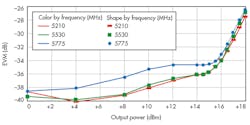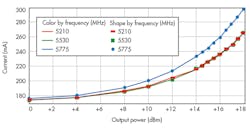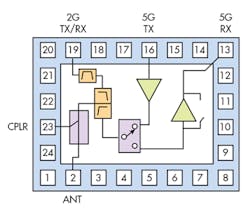This file type includes high resolution graphics and schematics when applicable.
Wi-Fi continues to be a strong, growing market, fueled by integration of this convenient wireless communications technology into mobile devices such as smartphones. Even as Wi-Fi gains ground, manufacturers of mobile devices and network equipment are rapidly making a transition from the earlier IEEE 802.11n wireless standard to the more capable IEEE 802.11ac standard.
Key differences between these communications standards include wider channels, higher-order modulation, and support for as many as eight spatial data streams using multiple-input, multiple-output (MIMO) configurations. Theoretical data rates for IEEE 802.11ac range from 433 Mb/s to nearly 7 Gb/s when employing all optional features. It’s easy to understand why users are so excited about gaining the new performance levels in their mobile communications devices made possible by IEEE 802.11ac.
The initial wave of wireless electronic products (Wave 1 products) implementing IEEE 802.11ac will take advantage of wide-bandwidth, 80-MHz channels (with optional 160-MHz bandwidth), modulation levels as high as 256-state quadrature amplitude modulation (256QAM), and MIMO antenna configurations as hearty as 8 × 8. The follow-up wave of wireless products employing IEEE 802.11ac (Wave 2 products) will achieve even higher performance levels by using more of the optional parameters detailed in the wireless standard.
Wave 1 products will provide data rates to about 1.3 Gb/s, or about three times the data rates possible for equipment employing the IEEE 802.11n standard. Wave 2 products will support multi-user MIMO configurations, which enables an access point to communicate concurrently with multiple devices over the same shared spectrum. As Wave 2 products become established, IEEE 802.11ac is expected to become the dominant Wi-Fi standard (by 2016), according to market-research firm IDC (www.idc.com).
IEEE 802.11ac creates new challenges for RF engineers working on mobile-device designs. Implementing MIMO in mobile-communications handsets increases system complexity and requires squeezing an additional RF chain into limited printed-circuit-board (PCB) real estate. Also, support of higher-order modulation formats requires higher transmitter linearity. In addition, Wi-Fi front-end solutions must generate sufficient transmit output power to maintain a desired operating range, while minimizing handset power consumption for extended battery lifetimes.
IEEE 802.11ac operates only in the 5-GHz band, which is less crowded than the 2.4-GHz band used by previous Wi-Fi standards. However, for compatibility with preexisting infrastructure and older wireless-communications devices, smartphones must still support 2.4-GHz communications. This requires careful attention to filtering requirements to avoid interference with Long-Term Evolution (LTE) cellular-communications bands.
Balancing Requirements
RF engineers must balance conflicting requirements to optimize Wi-Fi performance while managing power consumption. This requires careful system budgeting for each of the principal components of the device, including the Wi-Fi front-end module.
A key challenge with IEEE 802.11ac is to meet requirements for low dynamic error vector magnitude (EVM) while providing the necessary power output and low power consumption. The increase in modulation complexity from 64QAM in IEEE 802.11n to 256QAM in IEEE 802.11ac boosts throughput by 33%, but it also requires higher transmitter linearity, which is reflected by a more stringent EVM specification.
The system EVM requirement was tightened from –28 dB (4%) in IEEE 802.11n to –32 dB (2.5%) for IEEE 802.11ac when using 256QAM with a 5/6 coding rate. A suitable Wi-Fi front end must deliver even lower EVM, since the –32-dB system limit includes contributions from a front end’s Wi-Fi chipset.
Wi-Fi front-end solutions must meet this requirement while minimizing current consumption to prolong battery life and providing adequate output power to support the required operating range. To balance these demands, Qorvo developed a front-end module (FEM) dubbed the TQF6174 Wi-Fi integrated FEM (iFEM). It provides dynamic EVM (Fig. 1) of –35 dB (1.8%), with moderate current consumption of 225 mA and healthy output power of +15 dBm (Fig. 2).
Coexistence with LTE
Although IEEE 802.11ac operates only in the 5-GHz band, electronic devices designed for use with IEEE 802.11ac must also support 2.4-GHz Wi-Fi systems to be compatible with the millions of access points and other devices based on previous wireless standards. This poses the potential problem of interference between Wi-Fi signals at 2.4 GHz and signals within LTE cellular communications bands that use closely adjacent frequency spectrum.
The issue has intensified with more LTE bands being brought into service in support of greater global demand for mobile wireless data. The problem is particularly acute in China: the 2400- to 2482-MHz spectrum used by Wi-Fi lies between frequency bands 40 and 41, which are used by Chinese carriers to deliver time-division-duplex (TDD) LTE service. Band 7, which is used in other Asian countries and in Europe, is also close in frequency to the Wi-Fi spectrum, creating another potential source of interference.
Avoiding interference requires high-performance, Wi-Fi coexistence filters capable of rejecting signals in these adjacent LTE bands. With some filter technologies, the frequency response shifts significantly with changing temperature. Because only minimal gaps exist between Wi-Fi spectrum and LTE bands, this temperature drift becomes a major challenge—filters based on older technologies may be unable to meet coexistence requirements because the variation in response can exceed the width of the transition between bands.
Thus, newer filter technologies are needed that maintain a much more stable response to temperature variation, such as Qorvo’s LowDrift and NoDrift bulk-acoustic-wave (BAW) filters. Filters must also minimize insertion loss in the Wi-Fi transmission pathway, which is critical to help maintain a high signal-to-noise ratio (SNR) and correspondingly low EVM, and to improve receive sensitivity.
Handset manufacturers are moving to 2 × 2 MIMO, which can theoretically double data rates by using two simultaneous spatial data streams between the smartphone and MIMO-enabled access points. Supporting MIMO increases device complexity because it requires two, essentially identical, Wi-Fi transmit-receive chains within each device. Handset designs must accommodate this additional chain without requiring twice the PCB space. That’s because manufacturers want to use every available square millimeter within the handset for battery capacity to maximize Internet usage and talk time, as well as drive large smartphone screens.
The solution lies in progressively more integrated Wi-Fi front ends that leverage advanced packaging techniques to shrink module size. For example, the model TQF6174 iFEM from Qorvo (Fig. 3) integrates a power amplifier, low-noise amplifier (LNA), coexistence filter, switch, and diplexer into a miniature 4- × 3-mm package. It requires 24% less space than previous-generation components using a 2 × 2 MIMO configuration.
Each Wi-Fi generation brings new challenges for engineers working on mobile devices. Implementing IEEE 802.11ac in MIMO handsets requires highly integrated Wi-Fi front-end solutions that meet exacting requirements for linearity, power output, and current consumption. These solutions also simplify handset design, accelerating development of new products.
Kevin Gallagher is Senior Product Marketing Manager for Qorvo Inc.




